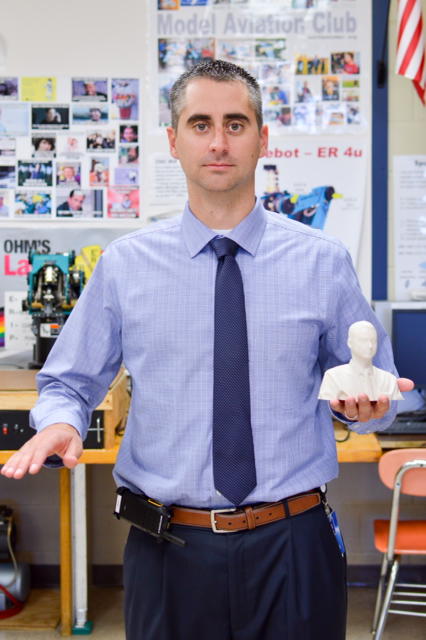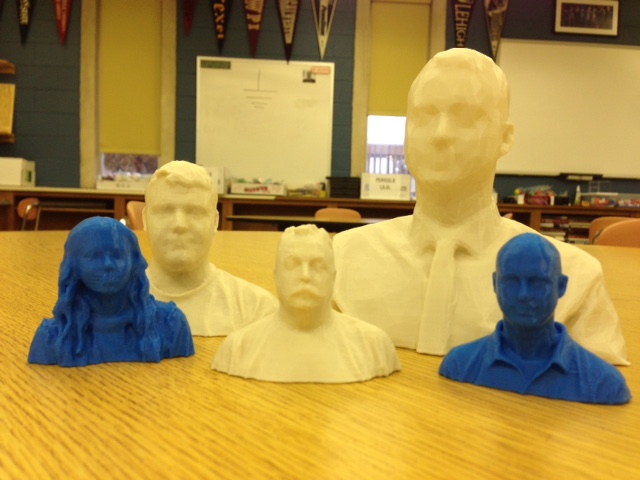Tech Ed classes take on new dimension
3D Scanning is the latest in innovations being explored by students in the NPHS Tech Ed program
3D prints are just the latest addition to the array of things possible in the NPHS Tech Ed Dept.
TOWAMENCIN- Tucked away in H-pod, Tech Ed teacher Curt Reichwein and students Julia Santos and TJ Schmidt have been exploring the potential of 3D scanning. Equipped with four 3D printers, an xbox 360 Kinect, and software, the trio is able to scan 3D objects and print them out. They have printed out busts of multiple individuals, including the German exchange students and Principal Todd Bauer.
It all started when Reichwein visited a STEM expo last April. There, he saw an individual with an xbox apparatus who could generate people on screen and print out their figure. “I can do that” Reichwein thought, so he bought the software and equipment necessary for the project. Bauer was in on the excitement and volunteered to be a guinea pig for the project.
“All I did was sit still during the scanning process” Bauer said. “I was, quite frankly, amazed! The scan itself took roughly thirty seconds. To have such a detailed replica is unbelievable. I am excited for the potential with this technology!”
The process is such: the individual being scanned must stay perfectly still while being scanned. A different individual holds the Kinect steady while slowly moving around the individual being scanned, being sure to capture as many areas in the scan as possible while being careful to keep the Kinect in range. This is a technique Santos has mastered, who is sure to cover areas like the top of the head and the chin so that there is no warped areas or spaghetti-like strands in the printed version of the scan.

“We try to make sure we get [the scan] as clean and crisp as possible” Santos said.
Meanwhile, the software shows filled and empty space in the scan: green as filled space and red as empty. When the scan is complete, the software uses small polygons to form the shape of the scan, causing the bust of the individual who was scanned to appear as if it was chiseled by a sculptor. The software is then used to fill any holes and crop the scan to a desired shape or size. Then, the scan is sent to the 3D printer to be printed. Printing time varies on the size of the scan. The whole process is documented and serves as a learning process for those involved.
“Overall the most exciting part of this project is the new technology I get to work with and the experiences and memories we are creating as the project moves along. There is never a dull moment.” Santos said.
As the project has and will continue to involve trial and error, Reichwein has been sure to teach his students about the importance of failure.
“Each time we scanned we got better” Reichwein said. “Failure provides progression and growth… the important thing is that the students have to fail. Failure is the option because without it we would never succeed”
Schmidt embraced failure while working on the project.
“Working with the 3D scanner is all about making mistakes and fixing them. I don’t think there is any other class that you are supposed to mess up in” Schmidt said.
Despite major success, the continuous project is still in its infancy. Areas of improvement include refining detail in the scans by using smaller polygons, creating an apparatus that is able to carry out uniform scans (rather than an individual carefully moving around to scan), and creating 20” figures of people like what Reichwein saw at the STEM expo he attended. In addition, the creation of objects such as pez dispensers and bobbleheads are being explored. Bauer recognized the potential of 3D printing and scanning, citing its importance to students.
“It is important to support all of our departments and their efforts to provide relevant learning opportunities for our students. It really is as simple as this: if something is important to students and their future success, we will support it!” Bauer said.


